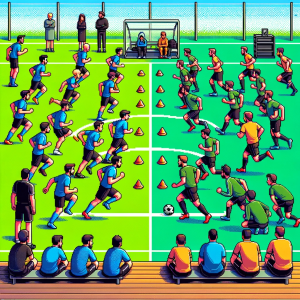
So you want to start a rec soccer league?
Starting a recreational soccer league for adults in your community is a wonderful initiative that can bring people together, promote fitness, and foster a sense of camaraderie. Whether you’re a soccer enthusiast, a community leader, or just someone looking to make a positive impact, launching a league requires thoughtful planning and organization. In this blog post, we’ll explore key considerations to help you successfully start and run an adult recreational soccer league.
1. Understand Your Community’s Interests and Needs
Before diving into the logistics, it’s crucial to gauge the interest level in your community. Conduct a survey or hold a community meeting to understand how many people would be interested in participating. This will give you an idea of the number of teams you can form and the scale of your league. Also, consider the demographic of your community; this will help in determining the type of league (competitive, co-ed, age-specific, etc.) that would be most appealing.
2. Set Clear Goals and Objectives
Define the purpose of your league. Is it purely for fun and social interaction, or does it have a competitive edge? Your goals might include promoting physical fitness, providing a social outlet, developing soccer skills, or simply bringing the community together. Having clear objectives will guide your decisions regarding league format, rules, and overall management.
3. Choose the Right Format and Rules
Decide on the league format that best suits your community’s needs. Will it be 5-a-side, 7-a-side, or traditional 11-a-side? Consider the availability of fields and the number of players. Smaller-sided games can be more suitable for communities with limited space or players. Establish a set of rules and make sure they are communicated clearly to all participants. You can start with the basic FIFA rules and modify them as needed to suit your league.
4. Secure Facilities and Equipment
Finding a suitable venue is one of the most critical steps. You’ll need a field that can accommodate your league’s format. Reach out to local schools, parks, and sports complexes to inquire about availability and rental costs. Also, ensure you have the necessary equipment, including soccer balls, goals, and field marking tools. Don’t forget about safety equipment like first aid kits.
5. Organize Teams and Scheduling
Once you know how many people are interested, you can start forming teams. You might allow players to form their own teams or assign players to teams to ensure balance. Create a schedule that works for most people, considering weekdays, weekends, and evening options. Make sure to have a system in place for handling reschedules or cancellations.
6. Registration and Fees
Decide if you’ll charge a registration fee. Fees can cover the costs of field rentals, equipment, referees, and other expenses. Keep the fees reasonable to encourage participation. Offer online registration to make the process easier, and ensure you have a system for tracking payments and player information.
7. Hire Referees and Staff
For the league to run smoothly, you may need to hire referees and possibly other staff like a league coordinator or field maintenance personnel. You can reach out to local referee associations or sports organizations to find qualified referees. Consider training volunteers if your budget is limited.
8. Promote Your League
Effective promotion is key to attracting players and building excitement. Use social media, community bulletin boards, local newspapers, and word of mouth to advertise your league. Highlight what makes your league unique and appealing. Consider partnering with local businesses for sponsorships or promotions.
9. Plan for Safety and Liability
Prioritize safety at all times. This includes having a clear plan for injuries, weather emergencies, and other unforeseen circumstances. It’s also advisable to have liability insurance for your league to protect yourself and your organization.
10. Foster a Community Spirit
Remember, one of the main goals is to build community. Encourage sportsmanship, teamwork, and fun. Organize social events like post-game gatherings or end-of-season parties. This will help create a sense of belonging and keep players coming back season after season.
11. Evaluate and Improve
After your first season, take time to evaluate how things went. Get feedback from players, referees, and any staff involved. What worked well? What could be improved? Continuous improvement will help your league grow and thrive.
12. Consider Expansion or Partnerships
Once your league is established, consider expanding or forming partnerships. You could add more teams, different age groups, or collaborate with nearby communities for inter-league play. Partnerships with local businesses can provide additional resources and exposure.
Conclusion
Starting an adult recreational soccer league is a rewarding endeavor that can have a lasting impact on your community. By considering these key factors and planning carefully, you can create a league that is enjoyable, well-organized, and sustainable. Remember, the success of your league depends not just on the soccer played, but on the community it builds and the positive experiences it provides.



